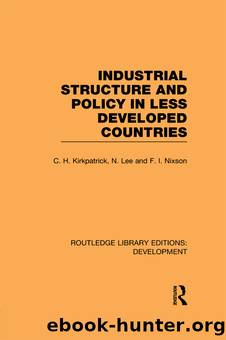Industrial Structure and Policy in Less Developed Countries by Kirkpatrick Colin;Lee N.;Nixson Fred;Nixson Fred;

Author:Kirkpatrick, Colin;Lee, N.;Nixson, Fred;Nixson, Fred;
Language: eng
Format: epub
ISBN: 614872
Publisher: Taylor & Francis Group
4.17 THE DEVELOPMENT OF SMALL-SCALE ENTERPRISES22
The discussion of small-scale industrial enterprise development and the problems associated therewith obviously overlaps with the discussion of the informal sector (Chapter 3, section 3.2) and with the examination of the development of indigenous industrial entrepreneurship and management (section 4.16 above). Nevertheless, a number of new issues are raised and they require separate treatment.
The definition of a âsmall enterpriseâ is not always straightforward as there are many different types of small-scale industrial enterprise activity, differing with respect to both size and nature and characteristics of operations. There are the traditional household or cottage enterprises; small factory enterprises, which have often developed from the former and retain some of their characteristics; and modern factory enterprises, where the absence of significant economies of scale makes small-scale production feasible (Sutcliffe, 1971, ch. 6, section 6.7). Cottage or handicraft enterprises can themselves be subdivided between those that manufacture a high-quality product of artistic value, which can be sold to tourists and/or exported, and those that make a low-cost, low-quality product under primitive conditions serving low-income, local markets, and for which there is a minimal growth potential (Bryce, 1965, ch. 4).
A survey of the available empirical evidence noted a general tendency for small-scale enterprises to be relatively more important in the LDCs than in the developed industrialised economies, but pointed to the fact that, while the average size of enterprise was smaller in LDCs, the size distribution was such that a few large firms dominated the markets for particular products. In many LDCs, therefore, âthere is an enormous number of very small firms and a small number of very large firms ⦠[but there is] ⦠a lack of medium-sized factory industry which is common in more industrialised countriesâ (Sutcliffe, 1971, pp. 235-6).
This is not a static situation, however. Anderson (1982, p. 914), extending ideas first advanced by Hoselitz (1959), identified three phases through which manufacturing activities, classified according to scale, pass during the process of industrialisation:
(1) a phase in which household manufacturing is predominant, accounting for one-half to three-quarters or more of total manufacturing employment;
(2) a phase in which small workshops and factories emerge at a comparatively rapid rate, and act to displace household manufacturing in several sectors; and
(3) a phase in which large-scale production becomes predominant, displacing the remaining household manufacturing activities and a large share â though not the whole â of workshop and small factory production.
These are not totally separate phases and there is some overlap between them. Furthermore, when the urban informal sector activities are sufficiently disaggregated, many of them are found to provide earnings opportunities over relatively long periods of time and are likely to thrive, rather than disappear, as industrialisation proceeds. King (1974), for example, likened the informal manufacturing sector to a âmoving frontierâ, taking over, year by year, a wider range of products.
These changes are in part the result of the varying relationships between small-scale and large-scale industrial plants in LDCs. Where both produce competitive products, large-scale (modern) plants will in time drive the small-scale out of business.
Download
This site does not store any files on its server. We only index and link to content provided by other sites. Please contact the content providers to delete copyright contents if any and email us, we'll remove relevant links or contents immediately.
International Integration of the Brazilian Economy by Elias C. Grivoyannis(74660)
The Radium Girls by Kate Moore(11619)
Turbulence by E. J. Noyes(7700)
Nudge - Improving Decisions about Health, Wealth, and Happiness by Thaler Sunstein(7242)
The Black Swan by Nassim Nicholas Taleb(6762)
Rich Dad Poor Dad by Robert T. Kiyosaki(6174)
Pioneering Portfolio Management by David F. Swensen(6078)
Man-made Catastrophes and Risk Information Concealment by Dmitry Chernov & Didier Sornette(5646)
Zero to One by Peter Thiel(5488)
Secrecy World by Jake Bernstein(4388)
Millionaire: The Philanderer, Gambler, and Duelist Who Invented Modern Finance by Janet Gleeson(4093)
The Age of Surveillance Capitalism by Shoshana Zuboff(3983)
Skin in the Game by Nassim Nicholas Taleb(3965)
The Money Culture by Michael Lewis(3846)
Bullshit Jobs by David Graeber(3828)
Skin in the Game: Hidden Asymmetries in Daily Life by Nassim Nicholas Taleb(3720)
The Dhandho Investor by Mohnish Pabrai(3560)
The Wisdom of Finance by Mihir Desai(3523)
Blockchain Basics by Daniel Drescher(3329)
